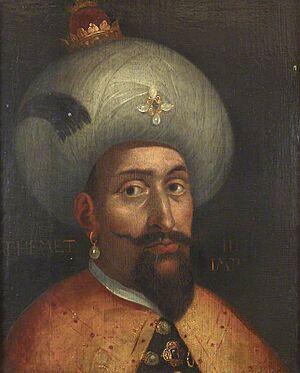Mehmed III facts for kids
Quick facts for kids Mehmed III |
|||||
|---|---|---|---|---|---|
| Ottoman Caliph Amir al-Mu'minin Custodian of the Two Holy Mosques |
|||||
 |
|||||
| Sultan of the Ottoman Empire (Padishah) | |||||
| Reign | 16 January 1595 – 22 December 1603 | ||||
| Predecessor | Murad III | ||||
| Successor | Ahmed I | ||||
| Born | 26 May 1566 Manisa Palace, Manisa, Ottoman Empire |
||||
| Died | 22 December 1603 (aged 37) Topkapı Palace, Istanbul, Ottoman Empire |
||||
| Burial | Hagia Sophia, Istanbul | ||||
| Consorts | Handan Hatun Halime Hatun Fülane Hatun |
||||
| Issue Among others |
Şehzade Mahmud Ahmed I Mustafa I |
||||
|
|||||
| Dynasty | Ottoman | ||||
| Father | Murad III | ||||
| Mother | Safiye Sultan | ||||
| Religion | Sunni Islam | ||||
| Tughra |  |
||||
Mehmed III (born May 26, 1566 – died December 22, 1603) was the sultan of the Ottoman Empire from 1595 until his death. He is remembered for leading the army in the Long Turkish War. During this war, the Ottoman army won a big victory at the Battle of Keresztes. He also stopped some major uprisings called the Jelali rebellions. Mehmed III also worked to improve trade with Elizabeth I, the Queen of England. He hoped England would become an ally against the Spanish.
Contents
Early Life
Mehmed was born in Manisa Palace on May 26, 1566. This was during the time of his great-grandfather, Suleiman the Magnificent. His father was Murad III, and his mother was Safiye Sultan. She was from Albania.
Mehmed's great-grandfather, Sultan Suleiman I, died the year Mehmed was born. His grandfather, Selim II, became the new sultan. When Mehmed was eight, his grandfather died, and his father, Murad III, became sultan in 1574. Mehmed was 28 years old when his father died in 1595. He spent most of his early life in Manisa with his parents and his teacher.
Reign as Sultan
Securing the Throne
When Mehmed III became sultan, he had his nineteen brothers executed. This was a sad but sometimes common practice in the Ottoman Empire. It was done to prevent future wars and arguments over who would rule next.
Power Struggles in the Palace
Mehmed III often let his mother, Safiye Sultan, handle government matters. She was known as the valide sultan, which means "mother sultan." One of his first big challenges was a rivalry between two of his top advisors, Serhad Ferhad Pasha and Koca Sinan Pasha. His mother supported Koca Sinan Pasha. This disagreement caused problems with the janissaries, who were elite soldiers. In the end, Mehmed III removed Serdar Ferhad Pasha and replaced him with Sinan.
War with Austria-Hungary
A major event during Mehmed's rule was the Austro-Ottoman War in Hungary. This war lasted from 1593 to 1606. When the Ottoman army faced defeats, Mehmed III decided to lead the army himself. He was the first sultan to do this since Suleiman I in 1566.
With the Sultan leading, the Ottomans captured the city of Eger in 1596. They then faced the armies of the Habsburg Empire and Transylvania at the Battle of Keresztes. The Ottomans won this important battle. After his victory, Mehmed returned to Istanbul. However, the war continued, and the Ottomans lost some important places like Győr.
Jelali Uprisings
Another big challenge during Mehmed's reign was the Jelali revolts. These were uprisings in Anatolia, a region in modern-day Turkey. One leader, Karayazıcı Abdülhalim, even declared himself a sultan in 1600. Mehmed ordered his forces to deal with these rebels very strictly. Although Abdülhalim was defeated, his brother, Deli Hasan, continued the rebellion. He captured and burned the city of Kütahya.
Relations with England
In 1599, Queen Elizabeth I of England sent many gifts to the Ottoman court. These gifts were meant to strengthen the friendship between the two countries. They included a large, jewel-covered clockwork organ. This amazing machine had dancing sculptures and singing blackbirds. Queen Elizabeth also sent a special coach and a letter to Mehmed's mother, Safiye Sultan.
England wanted to be allies with the Ottomans because they faced a threat from the Spanish Empire. An alliance could help both nations. Mehmed himself inspected the large English merchant ship that brought the gifts. This showed him England's strong navy and encouraged him to build up his own fleet. However, a full alliance between England and the Ottomans never happened.
Death
Mehmed III died on December 22, 1603, when he was 37 years old. Some sources say he was very sad about the death of his son, Şehzade Mahmud. Other sources suggest he died from an illness like the plague or a stroke. He was buried in the Hagia Sophia Mosque. His 13-year-old son, Ahmed I, became the next sultan.
Family
Consorts
Mehmed III had three known consorts (main partners):
- Handan Hatun: She was the mother of Sultan Ahmed I.
- Halime Hatun: She was the mother of Sultan Mustafa I.
- Fülane Hatun: She died in 1598 with her baby son during an outbreak of illness.
Sons
Mehmed III had at least eight sons, including:
- Şehzade Mahmud: He was executed by his father in 1603.
- Ahmed I: He became the 14th Sultan of the Ottoman Empire after his father's death.
- Mustafa I: He later became the 15th Sultan of the Ottoman Empire.
See also
 In Spanish: Mehmed III para niños
In Spanish: Mehmed III para niños


